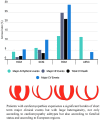Prospective follow-up in various subtypes of cardiomyopathies: insights from the ESC EORP Cardiomyopathy Registry
- PMID: 33035297
- PMCID: PMC7962774
- DOI: 10.1093/ehjqcco/qcaa075
Prospective follow-up in various subtypes of cardiomyopathies: insights from the ESC EORP Cardiomyopathy Registry
Abstract
Aims: The European Society of Cardiology (ESC) European Observational Research Programme (EORP) Cardiomyopathy Registry is a prospective multinational registry of consecutive patients with cardiomyopathies. The objective of this report is to describe the short-term outcomes of adult patients (≥18 years old).
Methods and results: Out of 3208 patients recruited, follow-up data at 1 year were obtained in 2713 patients (84.6%) [1420 with hypertrophic (HCM); 1105 dilated (DCM); 128 arrhythmogenic right ventricular (ARVC); and 60 restrictive (RCM) cardiomyopathies]. Improvement of symptoms (dyspnoea, chest pain, and palpitations) was globally observed over time (P < 0.05 for each). Additional invasive procedures were performed: prophylactic implantation of implantable cardioverter-defibrillator (ICD) (5.2%), pacemaker (1.2%), heart transplant (1.1%), ablation for atrial or ventricular arrhythmia (0.5% and 0.1%). Patients with atrial fibrillation increased from 28.7% to 32.2% of the cohort. Ventricular arrhythmias (VF/ventricular tachycardias) in ICD carriers (primary prevention) at 1 year were more frequent in ARVC, then in DCM, HCM, and RCM (10.3%, 8.2%, 7.5%, and 0%, respectively). Major cardiovascular events (MACE) occurred in 29.3% of RCM, 10.5% of DCM, 5.3% of HCM, and 3.9% of ARVC (P < 0.001). MACE were more frequent in index patients compared to relatives (10.8% vs. 4.4%, P < 0.001), more frequent in East Europe centres (13.1%) and least common in South Europe (5.3%) (P < 0.001). Subtype of cardiomyopathy, geographical region, and proband were predictors of MACE on multivariable analysis.
Conclusions: Despite symptomatic improvement, patients with cardiomyopathies remain prone to major clinical events in the short term. Outcomes were different not only according to cardiomyopathy subtypes but also in relatives vs. index patients, and according to European regions.
Keywords: MACE; Prognosis; Registry; Cardiomyopathy.
Published on behalf of the European Society of Cardiology. All rights reserved. © The Author(s) 2020. For permissions, please email: journals.permissions@oup.com.
Figures




Comment in
-
Measuring outcomes in patients with cardiomyopathy: which patients are we measuring outcomes in?Eur Heart J Qual Care Clin Outcomes. 2021 Mar 15;7(2):111-113. doi: 10.1093/ehjqcco/qcab001. Eur Heart J Qual Care Clin Outcomes. 2021. PMID: 33480987 No abstract available.
References
-
- Elliott P, Andersson B, Arbustini E, Bilinska Z, Cecchi F, Charron P et al. Classification of the cardiomyopathies: a position statement from the European Society Of Cardiology Working Group on Myocardial and Pericardial Diseases. Eur Heart J 2007;29:270–276. - PubMed
-
- Maron BJ, Towbin JA, Thiene G, Antzelevitch C, Corrado D, Arnett D et al.; American Heart Association; Council on Clinical Cardiology, Heart Failure and Transplantation Committee; Quality of Care and Outcomes Research and Functional Genomics and Translational Biology Interdisciplinary Working Groups; Council on Epidemiology and Prevention. Contemporary definitions and classification of the cardiomyopathies: an American Heart Association Scientific Statement from the Council on Clinical Cardiology, Heart Failure and Transplantation Committee; Quality of Care and Outcomes Research and Functional Genomics and Translational Biology Interdisciplinary Working Groups; and Council on Epidemiology and Prevention. Circulation 2006;113:1807–1816. - PubMed
-
- Charron P, Elliott PM, Gimeno JR, Caforio ALP, Kaski JP, Tavazzi L et al.; EORP Cardiomyopathy Registry Investigators. The Cardiomyopathy Registry of the EURObservational Research Programme of the European Society of Cardiology: baseline data and contemporary management of adult patients with cardiomyopathies. Eur Heart J 2018;39:1784–1793. - PubMed
-
- McKenna WJ, Maron BJ, Thiene G. Classification, epidemiology, and global burden of cardiomyopathies. Circ Res 2017;121:722–730. - PubMed
-
- Lund LH, Edwards LB, Dipchand AI, Goldfarb S, Kucheryavaya AY, Levvey BJ et al. The registry of the International Society for Heart and Lung Transplantation: thirty-third Adult Heart Transplantation Report-2016; focus theme: primary diagnostic indications for transplant. J Heart Lung Transplant 2016;35:1158–1169. - PubMed
Publication types
MeSH terms
Grants and funding
LinkOut - more resources
Full Text Sources
Medical

